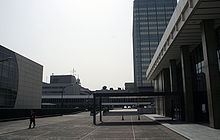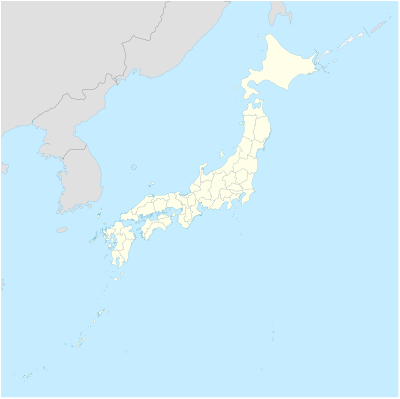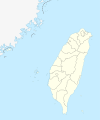NHK
![]()
The title of this article is ambiguous. For other meanings, see NHK (disambiguation).
![]()
This article or section is still missing the following important information:
Information on organisation and committees is missing
Help Wikipedia by researching and adding them.
The Nippon Hōsō Kyōkai (jap. 日本放送協会, literally: Japan Broadcasting Corporation), also abbreviated in Japanese with the Latin letters NHK (enu eichi kei), is the only public broadcasting corporation in Japan. It operates several nationwide television and radio programs and an extensive overseas service called NHK World (Radio Japan/NHK World TV). NHK collects broadcasting fees. Its headquarters are in Shibuya, Tokyo Prefecture. The legal basis for NHK is the Broadcasting Act (放送法, Hōsō-hō) of 1950. It is organized as a parastatal corporation (jap. 特殊法人, tokushu hōjin, literally: special corporation). The chairman (kaichō) has been Ryōichi Ueda since January 2017.

Logo of the Nippon Hōsō Kyōkai

NHK broadcasting center in the Jinnan district, Shibuya, Tokyo.
Foundation
|
| ||||||||||||||||||
| NHK's main transmitter and associated transmitters on Taiwan (lower left map), in Korea and Manchuria (1939) |
The Nippon Hōsō Kyōkai was formed on New Year's Day 1926 from the merger of the Tokyo radio station (Tōkyō Hōsōkyoku, 東京放送局, founded in 1924), whose first president was Gotō Shimpei, with those in Nagoya and Osaka. 1925 had seen the first radio broadcast in Japan.
In 1948, NHK began public television test broadcasts, which were broadcast regularly from 1950. On February 1, 1953, NHK became the first station to begin regular television broadcasting, with the necessary equipment designed by NHK itself. By the start date, there were 866 reception contracts, with about half of those viewers being radio amateurs with home-built television receivers. Initially, there were only transmitting stations in Tokyo, Nagoya and Osaka, linked by directional radio. By 1956, this covered major cities across the country.
In contrast to the German-speaking world, where private-sector competition did not appear until decades later, the first Japanese private station, Nippon TV, went on the air as early as August 28, 1953.
On January 10, 1959, the second NHK station NHK Kyōiku Television (NHK教育テレビジョン, NHK Kyōiku Terebishon, English NHK Educational TV) followed.
Television
The channel produces two nationwide full terrestrial television channels: Sōgō terebi (総合テレビ, roughly "general television", English: NHK General TV, abbreviated as NHK G) on Channel 1 (Tokyo) and Kyōiku Terebi (教育テレビ, "educational television", abbreviated as Eテレ, ī tere, English: NHK Educational TV, abbreviated as NHK E) on Channel 3 (Tokyo). General TV is NHK's main channel, which broadcasts mostly news and entertainment programs. NHK's main programme is supplemented at certain times by regional news and reports. These are fed from NHK studios in the regions or prefectures of Japan. The Educational TV channel's programming consists of 80 percent educational programs. These are aimed primarily at a younger audience.
NHK broadcasts two other full channels via the BS satellite: BS1 and BS Premium (BSプレミアム). The former stations BS2 and BS-hi were combined in April 2011 to form BS Premium. BS1's focus is on news broadcasts and live sporting events. The BS Premium channel mainly broadcasts cultural and entertainment programs.
A self-produced news programme is broadcast every hour. In addition, there is the "Time for news from abroad", composed of news programs from BBC, ZDF, RTR, France 2, TVE, Al Jazeera, KBS, CCTV, ABC (USA) and CNN, each of which is broadcast bilingually.
While the satellite channels BS1 and BS Premium are often fed into cable networks, NHK General TV and NHK Educational TV are exclusively terrestrial - with the exception of the prefectures of Iwate, Miyagi and Fukushima, where they have only been available digitally via ISDB-T since July 2011 - and can be received via cable TV. It should be noted that the feed of digital satellite TV into the cable network is often done by reducing the data rate; this is necessary because the cable channels are operated in the NTSC channel raster, while the satellite transponders have the bandwidth common in Europe.
Search within the encyclopedia

